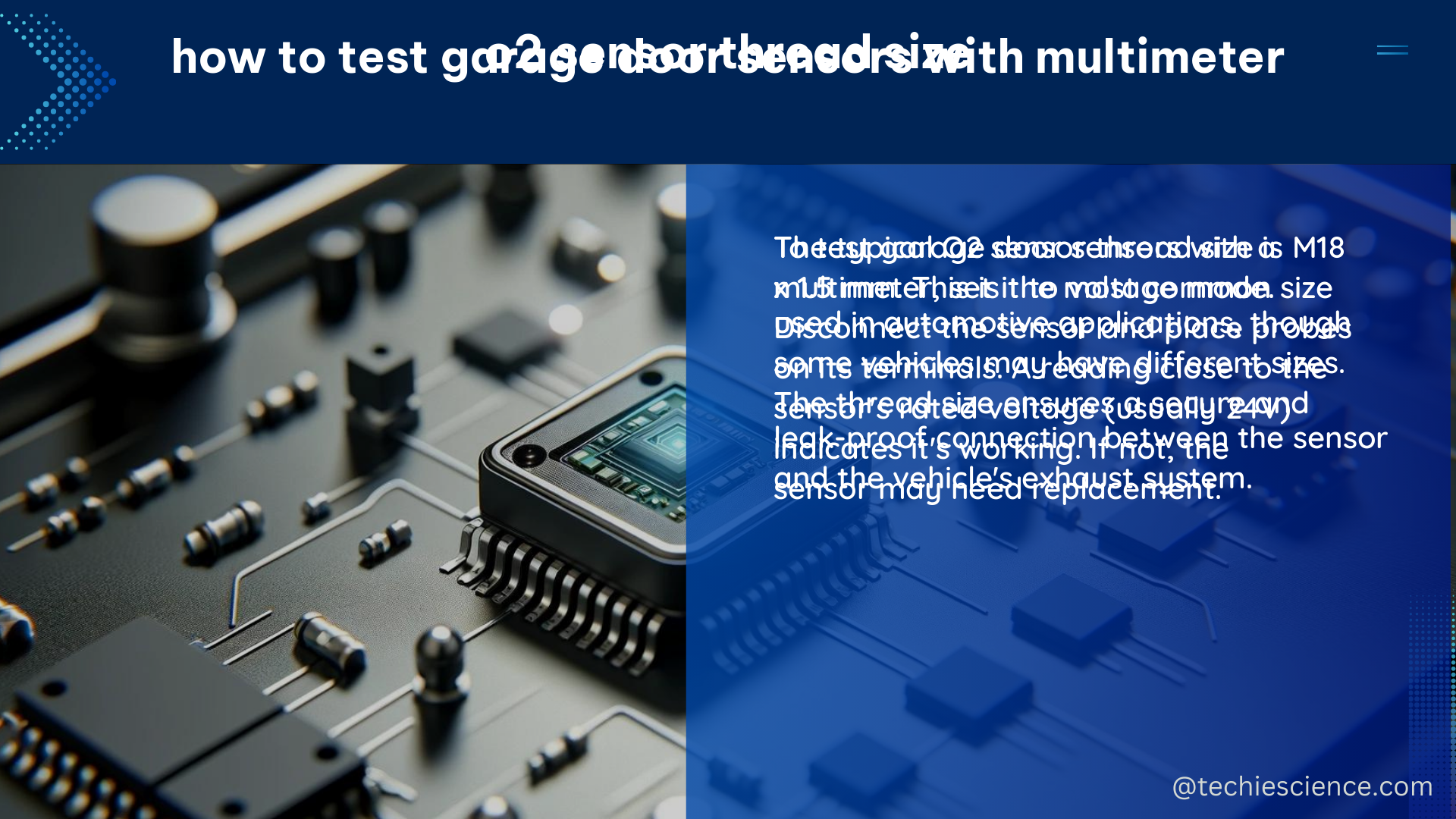The thread size of an oxygen (O2) sensor, also known as a lambda sensor, is a critical specification that determines its compatibility with a vehicle’s exhaust system. Understanding the intricacies of O2 sensor thread sizes is essential for ensuring proper sensor function, optimizing engine performance, and maintaining compliance with emissions regulations.
Decoding O2 Sensor Thread Sizes
The most common O2 sensor thread sizes are M18 x 1.5 and M22 x 1.5, where “M” denotes a metric thread, and the numbers represent the thread diameter and pitch, respectively. These thread sizes are widely used across various vehicle makes and models, but it’s important to note that some vehicles may utilize other thread sizes as well.
| Thread Size | Diameter (mm) | Pitch (mm) |
|---|---|---|
| M18 x 1.5 | 18 | 1.5 |
| M22 x 1.5 | 22 | 1.5 |
To accurately measure the thread size of an O2 sensor, you can use a thread gauge or a micrometer. A thread gauge is a specialized tool that allows you to determine both the diameter and pitch of a thread, while a micrometer is primarily used to measure the thread diameter with high precision.
Factors Influencing O2 Sensor Compatibility

While the thread size is a crucial factor in determining O2 sensor compatibility, it’s not the only consideration. Other important specifications include:
-
Voltage Output: O2 sensors produce a voltage signal that varies based on the oxygen content in the exhaust. Ensuring the sensor’s voltage output is compatible with the vehicle’s engine control unit (ECU) is essential for proper sensor function.
-
Response Time: The sensor’s response time, or the time it takes to detect changes in oxygen levels, is crucial for accurate air-fuel ratio monitoring and engine management.
-
Temperature Range: O2 sensors must be able to withstand the high temperatures present in the exhaust system, typically ranging from 300°C to 800°C (572°F to 1,472°F).
-
Electrical Connector: The sensor’s electrical connector must be compatible with the vehicle’s ECU to ensure proper signal transmission and integration.
When selecting an O2 sensor, it’s crucial to consider all these factors to ensure a proper fit and optimal performance.
Installation and Maintenance Considerations
Proper installation and maintenance of the O2 sensor are critical for ensuring accurate and reliable sensor performance. Here are some key considerations:
-
Torque Specifications: Tightening the O2 sensor to the correct torque specification is essential to prevent leaks and ensure a secure fit. Refer to the manufacturer’s instructions or the vehicle’s service manual for the recommended torque values.
-
Sensor Orientation: Ensure the O2 sensor is installed in the correct orientation, as specified by the manufacturer. Improper orientation can lead to inaccurate readings and sensor failure.
-
Sensor Replacement: O2 sensors have a limited lifespan and should be replaced at the intervals recommended by the vehicle manufacturer or when the sensor’s performance begins to degrade.
-
Sensor Calibration: Some vehicles may require periodic calibration of the O2 sensor to maintain optimal performance. Consult the vehicle’s service manual for the recommended calibration procedures.
-
Sensor Diagnostics: Regular monitoring and diagnosis of the O2 sensor’s performance, using tools like a digital multimeter or an OBD-II scanner, can help identify any issues and ensure the sensor is functioning correctly.
Conclusion
The thread size of an O2 sensor is a critical specification that must be carefully considered when selecting a replacement sensor for a vehicle. By understanding the common thread sizes, measuring techniques, and other compatibility factors, you can ensure a proper fit and optimal sensor performance, leading to improved fuel efficiency, reduced emissions, and enhanced engine performance.
References:
- Sensor Technology Handbook – OLLINTEC: http://ollintec.com/fie/sensores/libros/Sensor%20Technology%20Handbook.pdf
- Temperature Measurement and Control Catalog – Lakeshore: https://www.lakeshore.com/docs/default-source/product-downloads/lakeshoretc_l.pdf
- auszookers.com forum: https://www.auszookers.com/forum/viewtopic.php?f=5&t=13375
- NASA Systems Engineering Handbook: https://lws.larc.nasa.gov/vfmo/pdf_files/%5BNASA-SP-2016-6105_Rev2_%5Dnasa_systems_engineering_handbook_0.pdf
- SEMI International Standards: Compilation of Terms: https://www.semi.org/sites/semi.org/files/2020-02/CompilationTerms1218_0.pdf

The lambdageeks.com Core SME Team is a group of experienced subject matter experts from diverse scientific and technical fields including Physics, Chemistry, Technology,Electronics & Electrical Engineering, Automotive, Mechanical Engineering. Our team collaborates to create high-quality, well-researched articles on a wide range of science and technology topics for the lambdageeks.com website.
All Our Senior SME are having more than 7 Years of experience in the respective fields . They are either Working Industry Professionals or assocaited With different Universities. Refer Our Authors Page to get to know About our Core SMEs.